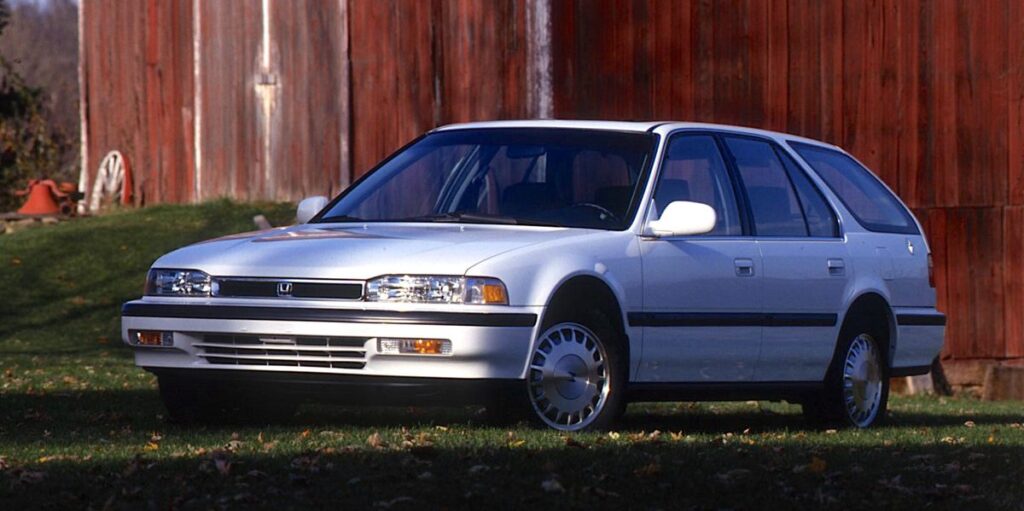1991 Honda Accord EX Wagon Is a Sedan with a Backpack

From the February 1991 issue of Car and Driver.
Mouthwatering station wagons come few and far between: the Audi Quattro, the Ford Taurus, the Mercedes 300, the Volvo Turbo. The first three showed up rounded, the last starkly boxlike, but all remain classy and well proportioned. About fifteen months ago, when Honda’s forward thinkers introduced today’s Accord sedans and coupes, they showed renderings presented as their own mouthwatering wagon. Its shape promised to outprofile even the world’s most handsome five-doors. Unlike many styling studies, this one was restrained enough to suggest a producible vehicle instead of a pure pipe dream. If the sketch came true, the Volvo, Mercedes, Ford, and Audi stylists would soon be frantically whittling away on some fresh five-doors.
Like a cloudburst in the desert, here comes the Honda to gully-wash the status quo. Yet the Accord Wagon hasn’t come out as svelte as we expected. It lacks, perhaps, in the sheetmetal what looked so attractive on the sketch pad. But get this: the freethinkers who dreamed up this potential flood tide work not out of Honda’s Japanese R&D center and studio but its American think tank and design enclave in Southern California. More irony: Honda will build the Accord wagon in the States—at its Marysville, Ohio, plant—for sale here and for export to Japan. Honda proves again that it can simultaneously move its markets in fast-forward and rapid-rewind.
Despite the stylish original plan, some details slipped away between the early rendering and the final fendering. The wagon’s bodywork remains leanly handsome, especially the aggressive nose, slick shell, and glassy cabin. But the windows along the appended “boot” don’t blend into its shape—or the shapes of the other side windows—as seamlessly as the artwork led us to expect. The Accord’s liftgate and taillights also fail to mesh as smoothly as they might. Yet overall the wagon comes across as distinctly trim—and trimmed for distinction. It bears a solid yet agile look, borne out by its basic solidity and dynamics.
Concentrations of cargo inevitably cram every station wagon at times. Cargo fills space the way work expands to fill time, the way play takes up leisure hours: The Honda’s cargo capacity, though not huge, can haul plenty that doesn’t require Mayflower movers. The nicely crafted carpet and panels encourage care in loading and unloading. We’d use pads or tarps to blunt heavy items with sharp edges.
Cargo-packaging choices include a rear seat split to fold forward in one-third, two-thirds, or full width according to needs—handy for skis (and crutches for aprés). To fold the rear seatbacks flat, you pull the bottom cushions up and flop them forward. Then you pull the rear headrests from their seatbacks, fold the backs forward, and safely slip the prongs of the rear headrests into receptacles on the backsides of the bottom cushion. A luggage cover mounted horizontally between the rear wheel wells unreels from just behind the rear seat. Configured like a window shade, the cover’s eyelets hook on to tabs near the tailgate, hiding whatever caboodle you’re carting around. Keeping the caboodle below the sills of the panoramic windows maintains excellent visibility out the tail and the right rear quarter. The driver’s B-pillar, the wagon’s only blind spot, stolidly blanks the view to the left rear quarter.
Larry Griffin|Car and Driver
The interior dimensions suggest Honda has decided to aim more at birth-controllers than population-explosionists. You’ll find plenty of room for luggage and four large travelers, but a maximum of only five will fit—and that’s only if the one sitting on the middle of the back seat is small enough to scuttle under a limbo bar without bending over backward. We say “sitting on” the rear seat because it’s as firm as a pew padded solely in shellac. Legroom front and rear proves adequate, extended in back by useful footroom under the front seats. The low bolsters up front make for comfortable support over long distances, presuming you don’t abuse winding roads as if you were attacking the Suzuka Circuit. But drivers who have long legs will find the Accord’s pedals set too close, its wheel too far. We can’t fathom why Honda fails in this respect to match Nissan, Toyota, and Mazda.
Honda packages an air bag in the nifty four-spoke steering wheel, replacing its add-on chrome “H” with the trademark molded into the padded hub cover.
The wagon wears the same stylish wheel applied to other Accords. They are—how to phrase it?—unobtrusively eye-catching. Though smooth in the modem aero idiom, their subtle curvature, angled inlets, and glossy machining catch the light and flicker like MTV. For an outfit with very little use for chrome, Honda has a way with brightwork; note the crystal-like cuts of the mirrors within the halogen headlights. The high beams throw an even spread of light but also highlight the problems of many headlights developed for use in countries with low speed limits: too much illumination directly in front of the car, not enough “throw” down the road. So your eyes, overwhelmed by your own pool of light, “stop down” like a camera lens that can’t be overridden—dimming the view of whatever lies further ahead, a dubious situation.
Honda’s 2.2-liter four-cylinder engine applies its fuel injection, sixteen valves, and balance shafts to producing a spicy 140 horsepower. Its performance, though flavored more along the lines of nutmeg than tabasco, whips up enthusiasm and lops off miles. The Accord’s five-speed, front-drive transaxle pulls the wagon’s 3170 pounds from 0 to 60 mph in 9.0 seconds and on up to a top speed of 119 mph.
The Accord wagon feels secure till you need better tracking, maximum cornering, or absolute braking. Pavement creased by truck ruts causes the chassis to wig-wag. Tricky corners can quickly tax the Goodyear Eagle GAs beyond the wagon’s 0.76-g cornering grip. Worse, maximum braking reveals poor front-rear balance and sorry 223-foot stops from 70 mph. These test results come as a shock from a chassis that feels good in the brisk driving invited by its basically good balance.
Nevertheless, we had hoped the wagon version of America’s best compact sedan would shine a little brighter. Honda is expected to ask twenty grand for it, a number big enough to rev up our expectations. Still, the Accord wagon is very tasty stuff. We bet Honda, in short order, will make it maximum delicious.
Arrow pointing downArrow pointing down
Specifications
Specifications
1991 Honda Accord EX Wagon
Vehicle Type: front-engine, front-wheel-drive, 5-passenger, 5-door wagon
PRICE
As Tested: $20,000 (est.)
ENGINE
DOHC 16-valve inline-4, aluminum block and head, port fuel injection
Displacement: 132 in3, 2156 cm3
Power: 140 hp @ 5600 rpm
TRANSMISSION
5-speed manual
DIMENSIONS
Wheelbase: 107.1 in
Length: 186.0 in
Curb Weight: 3170 lb
C/D TEST RESULTS
60 mph: 9.0 sec
1/4-Mile: 16.8 sec @ 82 mph
100 mph: 28.6 sec
Top Speed: 119 mph
Braking, 70–0 mph: 223 ft
Roadholding, 300-ft Skidpad: 0.76 g
C/D FUEL ECONOMY
Observed: 24 mpg
EPA FUEL ECONOMY
City: 24 mpg (est.)
C/D TESTING EXPLAINED



